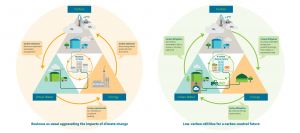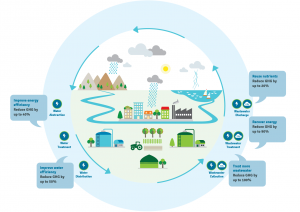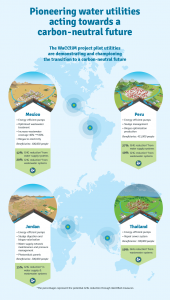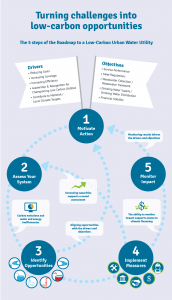The Urban Water Utility of the Future: ‘The Roadmap to a Low-Carbon Urban Water Utility’
LAUNCH
Thursday 20 September 2018, 09:45 – 10:30, IWA Pavilion
• The roadmap is the first guide of its kind to demonstrate a practical approach towards low-carbon, holistic and sustainable urban water management.
• Pilot utilities worldwide are significantly reducing their greenhouse gas emissions through targeted service performance improvements, from enhanced maintenance to new technologies and measures.
• The Roadmap is the flagship outcome from the WaCCliM Project, a joint initiative between the Deutsche Gesellschaft für Internationale Zusammenarbeit (GIZ) and the International Water Association (IWA), acting on behalf of the German Federal Ministry for the Environment, Nature Conservation and Nuclear Safety (BMU) as part of the International Climate Initiative (IKI).
19 September 2018, Tokyo, Japan. Water utilities are among the first vital urban infrastructure affected by climate change. Water scarcity, flooding, and deteriorated water quality directly hit utilities’ operations with fatal effects on provision of water and sanitation services.
While being concerned about climate change effects, the utilities themselves contribute to increased greenhouse gas emissions. Here, a mind-set shift to low-carbon solutions is urgently needed.
‘The Roadmap to a Low-Carbon Urban Water Utility’, a legacy from the Water and Wastewater Companies for Climate Mitigation (WaCCliM) project, is presented at the IWA World Water Congress & Exhibition 2018 to inspire a new generation of urban leaders and decision makers to transition towards carbon-neutral urban water and wastewater services.
“This roadmap supports water utility managers around the world in their efforts to improve performance and achieve carbon neutrality of their utilities while raising the awareness of policy-makers to the substantial contributions the water sector can provide in meeting greenhouse-gas reduction targets”, states Thomas Stratenwerth, Head of Division, General, European and International Water Management Issues, Federal Ministry for the Environment, Nature Conservation and Nuclear Safety, Germany.
“Diluted in the total global emissions, it might seem like a small contribution; however, if the urban water sector were to become carbon neutral, it could contribute the equivalent of 20% of the sum of committed reductions by all countries in the Paris Agreement (the Nationally Determined Contributions)”, said Corinne Trommsdorff, IWA-WaCCliM Project Director, and co-author of the report.
The Roadmap to a Low-Carbon Urban Water Utility draws on an approach that has been successfully piloted in utilities in Jordan, Mexico, Peru, and Thailand that participate in the WaCCliM project, with drastic reductions in greenhouse gas emissions.
The report showcases the diverse approaches adopted by water utilities. Some pilot utilities were able to plan and implement measures towards energy efficiency and increasing coverage, while others made progress towards higher awareness and policy influencing.
In San Francisco del Rincón, Mexico, the implemented measures have allowed SITRATA and SAPAF to lower the operational costs and improve productivity. The immediate impact of increasing wastewater treatment coverage is a 30% reduction in greenhouse gas emissions. This is equivalent to 2,500 tons of carbon dioxide per year and comparable to annual emissions of 650 people living in Mexico.
The water utility of Cusco (SEDACUSCO) faced with the challenge of reducing its wastewater treatment plant’s operating costs and odour nuisance. , It chose successfully Improvement of sludge management and biogas recovery as solution strategies . The results are promising: currently 5300 tons of carbon are saved every year, and future generation of electricity for internal use will allow savings of about USD 290,000 per year and 650 tons of carbon per year.
In Thailand, the Chiang Mai utility has achieved initial greenhouse gas reductions through sewer repairs and pumping cycle optimisation.
The Jordanian Miyahuna-Madaba Company, with the help of the University of Jordan, conducted studies to determine its overall operational baseline greenhouse gas emissions throughout the urban water cycle. This basic assessment was completed using the ECAM tool, a free software tool from the project, to measure and report greenhouse gas emissions from urban water services.
These forward-thinking utilities are heading the transition to low-carbon urban water utilities. The roadmap intends to support utilities around the world in understanding and championing the need for contributing to a carbon-neutral future, and to guide them through this process.
“The WaCCliM Project and the Roadmap to a Low-Carbon Urban Water Utility has provided solid evidence of how utilities can become leaders in climate mitigation and adaptation. We hope that many other utilities will be early adopters of the WaCCliM roadmap, as it will steer and inspire utilities worldwide towards a climate-resilient future”, said Kala Vairavamoorthy, IWA Executive Director.
ENDS
The report is available for download at: https://climatesmartwater.org/wp-content/uploads/2018/09/Roadmap-to-a-Low-Carbon-Urban-Water-Utility-2018.pdf
Figures are also available for download at www.ClimateSmartWater.org with a reference to their respective captions, as below.
For more information and/or interview please contact:
Corinne Trommsdorff, IWA Manager, Corinne.trommsdorff@iwahq.org
Marta Jiménez, IWA Communications Officer, marta.jimenez@iwahq.org
About WaCCliM
WaCCliM, which stands for Water and Wastewater Companies for Climate Mitigation, is a joint initiative between the Deutsche Gesellschaft für Internationale Zusammenarbeit (GIZ) and the International Water Association (IWA), acting on behalf of the German Federal Ministry for the Environment, Nature Conservation and Nuclear Safety (BMU) as part of the International Climate Initiative (IKI). The WaCCliM Project advocates for carbon neutrality of water utilities through the introduction of measures that can simultaneously enhance utility performance and reduce greenhouse gas (GHG) emissions. WaCCliM is currently working in four pilot countries with partners and key utilities: in Peru with MVCS (Ministerio de Vivienda, Construcción y Saneamiento) and the utility of SEDACUSCO in Cusco; in Mexico with CONAGUA (Comisión Nacional del Agua) and the utilities of San Francisco del Rincón, SAPAF and SITRATA; in Thailand with WMA (Wastewater Management Authority); and in Jordan with the Water Authority of Jordan and the water utility of Miyahuna Madaba. www.wacclim.org
About the International Water Association
The International Water Association is the largest international network of water professionals working towards a water wise world, with members in more than 130 countries. Its work focuses on developing solutions for water and wastewater management. As a knowledge hub for the latest science, technology and best practice in the water sector at large, the IWA works to place water on the global political agenda and to influence best practice in regulation and policy making. www.iwa-network.org
Downloadable figures:
Figure 1. The water–energy–carbon nexus: the GHG emissions from the urban water sector and opportunities to reduce them, demonstrating the vicious and virtuous cycles above. © WaCCliM
Figure 2. The UWC uses energy at every stage, and emits GHG in the wastewater stages. There are opportunities to reduce carbon emissions at every stage. © WaCCliM
Figure 3. Time is running out to keep our planet stable and
below a temperature rise of 2°C: taking purposeful decisions now
towards a carbon-neutral future can help avoid future risks. © WaCCliM
Figure 4. How can GHG emissions be reduced through operational improvement
measures? The WaCCliM project pilot facilities demonstrate some first examples. © WaCCliM
Figure 5. The roadmap to low-carbon urban water utilities: an iterative and continuous process. © WaCCliM





